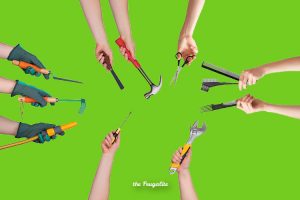(Psst: The FTC wants me to remind you that this website contains affiliate links. That means if you make a purchase from a link you click on, I might receive a small commission. This does not increase the price you’ll pay for that item nor does it decrease the awesomeness of the item. ~ Daisy)
(This is an excerpt from my book, The Ultimate Guide to Frugal Living.)
I’m willing to bet that it’s not just me.
Even though frugality has changed my life for the better and allowed me to afford things I never should be able to on my income, sometimes I chafe at the restrictions.
Don’t get me wrong. Most of the time, frugality is fun. Cheapskatery is a challenge that I relish. Doing something for free or cheap that other people spend money on gives me a little rush and I feel like I’ve “won.”
But every once in awhile, I wish I could spend freely without worrying about tomorrow. Sometimes, I want to go crazy at the grocery store and buy stuff because I want it, not because it’s on sale. Occasionally, I would like to splurge without the guilt.
When I feel like that, my motivation to do the activities that keep things cheap is about zero.
Do you ever lose your frugal mojo? These tips will help you stay motivated.
Give yourself a break.
Sometimes we all need it. Look in your budget and see if there is room for a little splurge. I find that for me, the best splurges are activities and not things most of the time. If I go buy something, often it only makes me happy for an hour or two. (Like a little kid with too many Christmas presents.)
Obviously, there are some things that prove this wrong – yarn, for example, gives me a long period of enjoyment because not only do I get to spend time making something, I get to enjoy the something I made, too.
But for the most part, if I’m going to spend some money, I grab my daughter and we head out on a road trip to have a little adventure. We might grab a meal out while we’re gone, and we’ll do something, like touring a cavern or visiting a historic place. Then, you are out and enjoying yourself on a carefree day while making memories with the people you love.
I always still handle money carefully and don’t allow this to give me permission to go hog wild. I withdraw cash from the ATM in the amount that I plan to spend and use my debit card ONLY in the case of an emergency.
Think about your goal.
Whatever your goal is, whether it’s early retirement, one parent staying home with the kids, being debt-free, putting your kid through college, leaving your job to go back to school, or moving to a dream location, keep that goal front and center. (In the next article, I’ll share the specifics of my own goal and exactly how I plan to get there.)
Find pictures that represent your goal and put them everywhere. Nothing keeps your motivation higher than a glimpse at the reason you’re living this life.
Think about what happens if you quit.
Sometimes a little negative reinforcement is in order, too.
What if you stop your frugal momentum? Will you be in the same place doing the same thing in five years instead of reaching your dream? Will the interest on your debt have stacked up to the point that paying it off will be a lot more daunting? Will you lose important things, like your home or car? Will your child have to go into debt for his or her education?
Knowing what you DON’T want is every bit as important as knowing what you DO want.
Spend time with like-minded people.
Okay, let’s face it. There’s nothing that makes you feel worse than going places with a spendthrift who is worse than a frat boy with a keg trying to get all the girls to have “just one more drink.”
Peer pressure is not the sole problem of teenagers and college kids. With adults, it’s just as bad, especially when you consider that those adults trying to get you to “live a little” may just want some justification for their own bad spending habits.
And it isn’t only friends who can make you feel bad. I remember when I was a young mom going out with some relatives. They didn’t really understand how desperate my financial situation was, and they’d constantly point out “great deals” for my little one and look at me disapprovingly when I didn’t snap them up. I felt HORRIBLE after a day out with them because, even though it was unintentional, their constant urging to spend when I had nothing available left me feeling guilty and embarrassed.
The joy of like-minded friends is that they don’t want to go out and frivolously spend money any more than you do. You can go to each other’s homes and enjoy a fresh-baked muffin and a cup of coffee and nobody is chomping at the bit to go to Starbucks and spend $10 apiece on the same treat. They’ll be your partner in crime going to yard sales and thrift stores. They will cheer on your cheap solutions instead of staring at you with their mouths agape in horror.
Indulge in frugality “porn.”
No, get your mind out of the gutter. By “porn” I mean immerse yourself in frugality. Find websites to check out. Reread this book. Go to Pinterest and search up budget-friendly DIYs. Read Amy Dacyczyn’s Tightwad Gazette yet again.
The last thing you want to do is watch regular TV with all the commercials for things you don’t need or flip through a magazine with all manner of designer things that cost more than you make in a month. Marketers go to school for a long time to learn how to make you want things you don’t need.
I like to keep a list of web destinations that will make me feel good about my frugal lifestyle. There are all sorts of sites out there dedicated to upcycling and frugal living that will make you feel inspired just looking at them.
Think about how much better off you are now that you’re in thrift mode.
This one is kind of mean, but also incredibly satisfying. If ever you’re feeling like the last kid picked for the dodgeball game, sit there and add up what other people are spending on things you get cheaply or for free.
Indulge for a moment in a feeling of superiority as you calculate their probably monthly budget and compare it to what you figure they make for a living. Then think about how much debt they must be in to live their current lifestyle. If you resist the urge to rub it in their spendy little faces, nobody is hurt by this exercise and you’ll feel smug and happy.
Hey, I warned you it was kind of mean, but be honest – wasn’t it fun?
Remember how great thrift is for the environment.
Instead of focusing on being cheap, think about the environment.
The awesome side effect of hardcore frugality is that it is much better for Mother Earth. We aren’t out there buying stuff in plastic packaging to be discarded each week. Most of us put far less garbage out to the curb than our spendier friends. We buy things from thrift stores and yard sales that would otherwise be on the way to a landfill.
We are like Neighborhood Greenpeace with our thrifty ways, right?
Give to others.
While things may be tight in your life right now, it’s a pretty sure bet that there are other people who are in worse shape. Realizing this will make you feel fortunate instead of morose about your own situation.
Do you have some pantry goods that you could spare to help somebody less fortunate? Is there a good deed you could do, like mowing the elderly neighbor’s lawn for her? Many people think that frugality rules out generosity, but I think it is just the opposite. It makes you really think about how hard it is to get by in the world these days and that makes you a much more compassionate person.
Even when I was incredibly broke, each week when we went to the grocery store, I would get my girls to pick out a package of pasta and a can of sauce to put in the food bank box near the exit of the store. We figured that would provide a warm meal to somebody that might not have one, and for the $2 it cost at the time, it was one small thing we could do for others. This helped my daughters too because if you are able to help others, you can’t possibly be that badly off, right?
What about you?
Do you ever get unmotivated? Do you ever find it difficult to stick to your frugal ways?
How do you crank up your thrifty mojo when you just want to spend money like everybody else does? Share your best tips in the comments.
(If you enjoyed this, please check out my book, The Ultimate Guide to Frugal Living.)












22 thoughts on “Keeping Your Frugal Mojo in a Spendy World”
I have been binge watching YouTube videos of a woman in Ireland who lives in a home in the forest. Her focus is mostly package free and simple living, but of course that goes hand in hand, (when done right,) with frugality. She talks about that a little too. I have gotten so many ideas and so much motivation from her videos. They motivate me no matter where my mind is at the moment; wanting to splurge, or wanting to be frugal. Sadly, I haven’t found many friends who share my obsession for frugality, so it’s important for me to find like-minded people to watch, (or read,) where ever I can… like here, or on YouTube.
No car. No house. No kids means No Child Support. No bike or other human powered vehicle. Cheap generic college degrees means I have little student loan debt. No credit cards live within my budget. I do not own any pets another expense. No girlfriend plenty of friends. That is F**ken Frugal.
I think if you could not afford the things , you should be honest. Not avoid people. And I don’t think it is necessary to use inappropriate words in comments. The stars don’t make it acceptable.JR
Sometimes i buy something that i think i want. Then end up returning it the next day or on my next trip. You need to watch return policies, tho, not all stores are the same. And right now, with COVID-19, no store is taking anything back.
Or i put something on my wish list, only to cross it off a day, a week, a month later, before i buy it.
Great point, Rod! We use Amazon wish list and put things in there when we want to go on a shopping spree. Then we go back in before a birthday or holiday and check to see what we really want. Usually we end up taking most of it back out. Putting it on the list seems to tell your spending brain that you could buy it, but you’re waiting to make sure it’s a good decision. That gives time to let one decide if it’s an impulse or really a keeper, while allowing that occasional binge of shopping. When you have a $25 Amazon gift card and hundreds of things you think you want, going back the next day to decide shows you that much instant gratification often wasn’t the most satisfying choice after all. I wish I’d learned this earlier in my life and just budgeted an amount every month, like $10 or $20, that I could spend freely but had to choose wisely. I wonder how much I would have saved back then?
We do something like this for larger purchases. We named it the “30 day rule”. We define larger purchases as a single item that is at or around $80 or more. The idea is that before we buy the item we have a 30 day waiting period. During this time, often a better, less expensive option presents or the burning “need” passes (because it wasn’t really a need! Lol). It is a practice that has served us well.
I don’t buy fashion. My mother is upset with my jeans and old shirts when I visit. My mother at 82 yrs old, still cuts my hair. I don’t have a collection of shoes and I don’t buy jewelry either. I buy most of my furniture off of craigslist used. Our cars are brought used. I don’t own a tv nor a video game player. I don’t have credit cards. We are building the house as we have money.
My expense is the internet, which also includes my VOIP phone. I am off grid. Now that places are not recognizing the Texas governors medical exception for mask, I can’t do a lot of shopping. World Market lost me as a customer! I do buy my laundry and cleaning supplies from My Green Fills, but it is non-toxic which I need for my husband and they ship. That is one of my true expenses.
Some other examples of motivation to go, or remain, frugal might include the case of Bob Wells (CheapRVliving channel on YouTube) who after an expensive divorce learned immediately that his new economics could not afford to maintain two households … so he was forced to move into a van and go full time nomadic … where he teaches others how to do the same.
Other classic examples might include the two guys who began a tiny electronics business in a home garage that much later morphed into the world famous Hewlett-Packard company. There are many stories of small businesses that were only possible because the creator(s) lived and spent as frugally as possible during the early critically survival make-or-break years — WITHOUT going to any lender or venture capital money source. There is a good literature on the process of self-funding such business creations and survival that is labeled today as bootstrapping. That’s a useful online search term to find such books — try BOOTSTRAPPING BUSINESS.
If you believe there’s personal value to you, whether economic or personal only (in your personal pursuit of happiness), in being a lifelong learner, there can be expenses involved. Your skills and instincts of frugality can help preserve your solvency as well, and make that historical personal pursuit (immortalized in the Declaration of Independence) financially possible. The largest library in world history (eclipsing the ancient Library of Alexandria in Egypt) is now the internet … with an astounding amount of free learning content, plus much low cost content that is competition for the ghastly expensive medieval college system (which will bankrupt many before such institutions go bankrupt themselves). In addition, there is the time-honored (since before 1900) interlibrary loan system that is either totally free (or sometimes dirt cheap) to the local library borrower for hard to find titles that most local libraries don’t have the economics to own.
Other motivations for frugality might include preserving the value of your cash earnings and/or inheritances because since 1913 the US money creation model has been converted into one of legal counterfeiting in order to fund the “permanent” warfare/welfare model that the 1694 creation of the Bank of England had long proved as successful in stealing additional purchasing power from the population’s cash holdings beyond what that population would tolerate by overt taxation (so the Crown would not risk being beheaded again). One seeming tiny measure of the currency destruction might be the 3 cent price of a 1950s US first class postage stamp which today has reached 55 cents despite the USPS habit of losing mail occasionally (including recent stories of mailed ballots for Trump). A more significant measure might be the $35/oz price of gold when Nixon took the final step of closing the gold window to foreign nations in 1971. Today’s price of gold around $1,880/oz per https://egoldadvisor.com/how-to-buy-gold/value-of-gold-per-ounce-live-chart/ is a relevant reminder that all fiat currencies historically are eventually destroyed by spend-happy governments. So there is considerable motivation in keeping a minimum of your wealth in cash (beyond enough to cover routine expenses and emergencies) to keep the legalized counterfeiters in government at arm’s length. Whether preserving that wealth in the form of learned business skills, precious metals, assets useful to increase your business earnings, or investments in others’ enterprises to provide a personal yield (sufficiently above the combination of taxes and inflation bites) to make the risks worthwhile is another decision of frugality of great significance. J. Paul Getty was famous for saying that keeping money was three times more difficult than making it in the first place. That puts the challenge of frugal thinking into a new perspective.
So the usefulness of a frugal mindset goes way beyond just getting a great discount on beans at your local grocer.
–Lewis
“Today’s price of gold around $1,880/oz …”
It would take 99 US $20 bills to buy one US $20 gold coin.
https://www.golddealer.com/product/saint-gaudens-gold-piece/
Inflation in action!
Simple question to ask yourself: “Why is this a PRIORITY RIGHT THIS MINUTE”…then count to 10….
How often do you get to 10?
Yes that is a rhetorical question.
I rarely do.
Wife usually has the tranquilizer dart gun out when I get to “3”…
My furniture was all free or cheap. 34″ Tv was a gift as was the pipe and antenna. Husband with alzheimers loves TV so he watches while i work around here.
I raise chickens, rabbits, and ducks. That’s mostly our eggs and meat. I grow a garden. I have fibromialgia and other problems so avoiding poisons on or in my food realky helps.
I had covid in April-May. I lost 30 lb and almost died. I’ve lost more weight since then. Bought pants and knit tops at a secondhabd store. I had to get new walmart underwear. Pants are 7 numbers down. So I had to get clothes. I’ve given away most of my “fat” clothes to people needing them.
I buy a few books. All found on the internet and shipped to me. Average price delivered is inder $4. Also some from secondhand stores. Mostly those are my gifts to others. Teens get older basic good scratch cookbooks. I’m a knitter but much of my yarn comes from a secondhand store. I make hats, scarves, and a few sweaters, and baby bIankets. To friends and neighbors I always gave food gifts. I have no oven now so I give homemade mixes for baking or seasonings in pretty jars. The jars are saved as we use up the contents. Paint the lids, remove the lables, and add a nice topper to the lid. Sometime I paint a label rectangle in blackboard paint. All get a cute tag with instructions.
I bought a treadle sewing machine. Mechanically I have it working well. I’m reglueing and repairing the drawers. I bought a full set of attachments in a cute antique fold out container original to them, delivered for under $25. I buy eBay thread, needles and more for less than driving 50+ miles to town and buying in stores.
My power was a solar array. Its been down for nearly a year. I have smaller solar power sources to recharge my phone, recharge batteries, and enough power to operate a TV and fridge a few hours a day. My lantern is rechargeable. My big bright flashlight has a set up inside to use 6 AA batteries in place of 4 D cells.
I love finding new ways to live well on less.
I grow or forrage a lot of ny critters foods. A new chicken coop will all be recycles materials and free pallets. The roof will be metal saved when a neighbor and i tore down an old mobilehome. I saved the rafters to one day cover a pit greenhouse. I plan ahead and save things, as well as cash.
I’ve heard about bundling batteries to avoid the more expensive ones. Can you tell me how you did it? Thanks!
Remember a penny saved is tax-free. I don’t grudge the amount that keeps good public order. I am horrified at the amount that shatters familes (child “protection” that kills both parents and kids) or kills innocents in other countries. Charity is best done locally.
I love your story about the yarn. I recently started learning to draw and make cartoons, and started a cartoon diary of things that happen to my family and friends throughout the year. It’s so relaxing and only costs a pencil and paper, maybe some crayons to be fancy. It’s a blessing to enjoy something like this, or birdwatching and enjoying walks in the park, and know that wonderfully special things don’t always require a plastic card.
Then there’s a little extra for someone who doesn’t have warm clothing, food to eat, or a warm blanket to use when sleeping outdoors. Thinking about where that money should really go, and that there is joy in simple things, helps me put the brakes on when I get jealous of someone buying bags of new clothes and shoes, or buying up an armful of books and magazines. There are other ways to get what we want that still allow us to share resources around more justly.
There is nothing so wonderful as sitting at the table with a cup of tea or coffee, talking with a good friend, while fresh bread cools on the sideboard enough to cut and put butter on it. No amount of money can buy that smell, that feeling, and that joy.
I recently found poshmark (website) that sells new & used items from people listing items for sale. With covid in 2020 not many sales & secondhand stores open in our area. Stores that are open, have more limited selections. Have found few nice new items for half off (retail) or more & vintage & secondhand items of interest. Mostly good experiences, knowing buying from individuals not corporations. Luckily being frugal has allowed me the opportunity to purchase some nicer items for cheap that will be used for years to come.
I have items on like (wish) list but have turned down offers because still not within my price range (willing to spend). I know that some items will have missed out on (once in lifetime) but remember that January is just around corner & increased heating bills, less hours on job (slow) & recent (unexpected) medical bills (that will need to be paid for).
As far as like minded people, that’s a changing position as some others just don’t understand our choices for living & goals. Or the actual costs of living (without outside help) even when you have job. For most part, there is no envy (on our part) but regrets for helping out so much (& always expected to which caused debt).
Looking forward to (hopefully) better 2021 & beimg able to look to practice more (& new) practices for being frugal.
Great find!!!!
Sorry Daisy for my off topic reply but cannot find where to renew receiving this site’ newsletter.
Just tried to change to a new email address and “succeeded” unsubscribing… 🙁
Thank you.
Hi, Dan! You can sign up right here. :). https://thefrugalite.com/sign-up-for-the-daily-frugalite/
Repairing helps a lot. Example: My Kitchenaid stand mixer is used a lot for bread baking. The motor seems to be struggling, and I will be taking it in for repair in the next couple of weeks. I am hoping the repair cost is but a fraction of the replacement cost.
Another example: My car is a 2007 Lexus hybrid SUV. I bought it new, and it was so expensive. But simple maintenance and a very few mechanical repairs has kept it going strong. I have just over 250K miles on it, and my mechanic tells me I will likely get 400K out of it before I have to retire it. Best financial decision I ever made.
I can and have replaced the innards of leaking toilets at a fraction of the cost to call out a service. I had a problem with my washer and, after researching to the end of the internet, I came to the conclusion that we needed a $35 part that could be replaced with just a few screws. I have a honeycomb blind on my dining table that has broken strings. That is my next challenge.
Long story short, those repairs quickly add up. It sometimes takes some time and effort to do the repairs oneself, but so worth it and oh so satisfying when it works out. And then, I don’t feel the least bit guilty if I buy a new tee (on sale and combined with loyalty perks) or fabric for a quilt (on sale and results in a useful item).
When I feel the need ti spend some money, I take $10-$20 into aDollar Tree n get 8-15 items to add to my preps. Its satisfying n helpful.
Thanks forthe many useful, thoughtful examples of thriftiness here…. Helpful!!